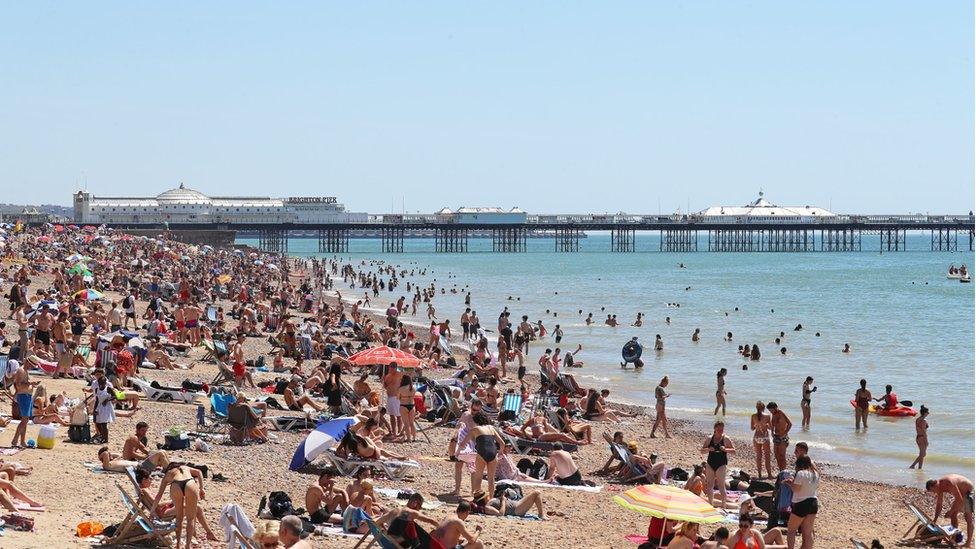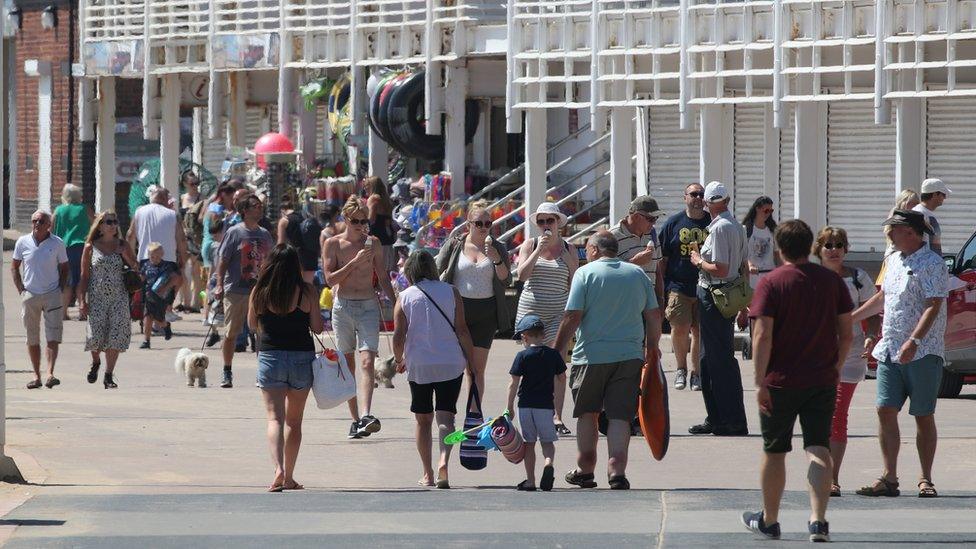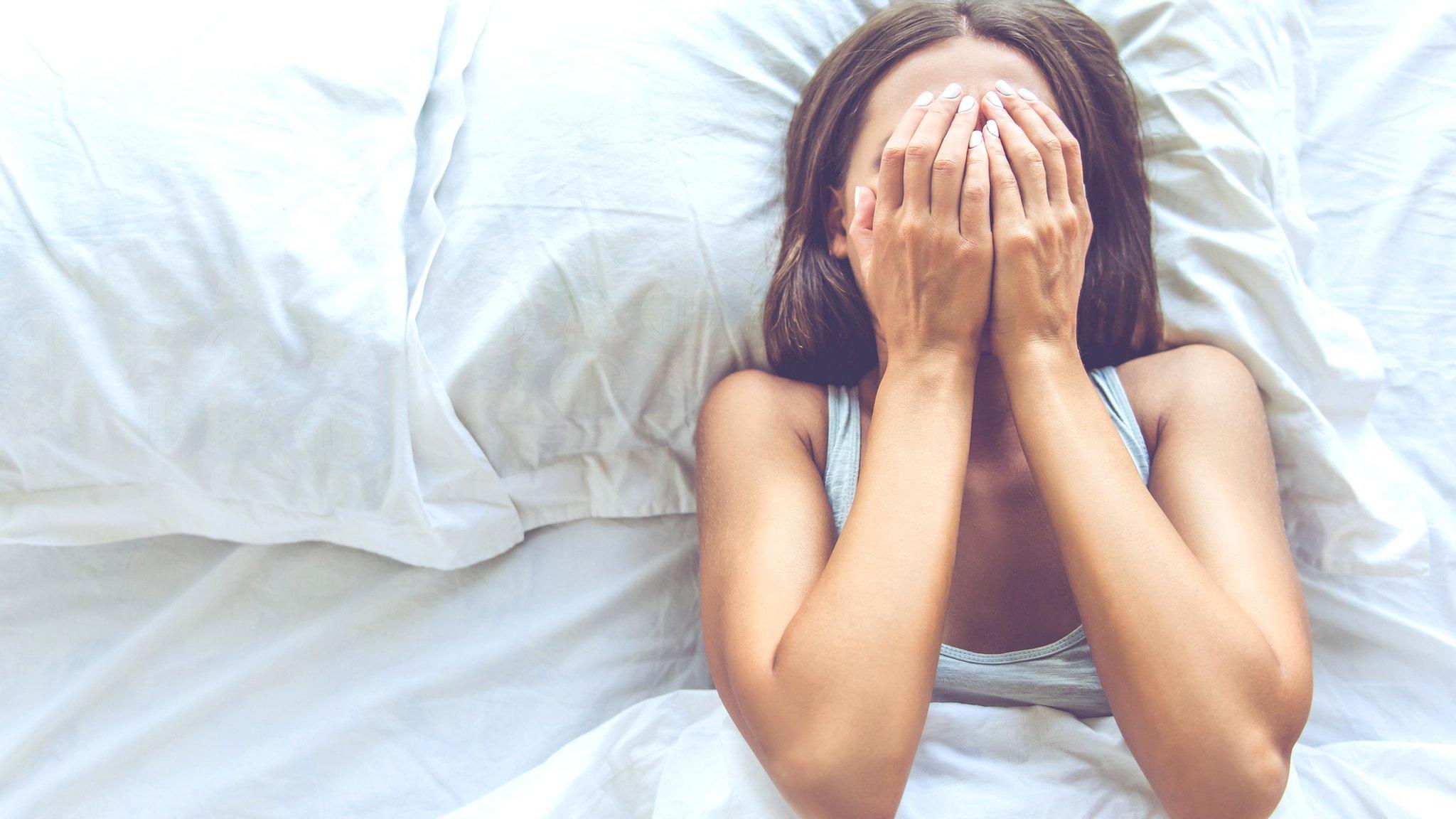UK weather: Hottest day of the year so far with highs of 33.3C
- Published
A major incident has been declared in Bournemouth on the second day of the UK heatwave
The UK is experiencing its hottest day of the year so far, with temperatures reaching 33.3C (92F) at Heathrow Airport, the Met Office has said.
Thursday's high surpasses the 32.6C recorded in London on Wednesday.
It comes after a major incident was declared in Bournemouth, as thousands of people headed to the Dorset coast.
Dorset Police urged people to stay away after reports of traffic gridlock, anti-social behaviour, fights and overnight camping.
People have also been cautioned to stay safe by Public Health England and the Met Office.
An amber level three heat-health alert, external, issued by the Met Office, was extended on Thursday to take in Yorkshire and the east and south of England as well as the West and East Midlands.
That means people should drink plenty of fluids, avoid consuming excess alcohol and "look out for" young children, babies and those with underlying health conditions, the Met Office said.
Public Health England (PHE) echoed the Met Office advice, saying older people, those with underlying health conditions, and very young children were all more at risk from the "exceptionally hot weather forecast this week".
Both Wales and Scotland also recorded their hottest days of the year on Thursday.
In Wales, the temperature reached 30.7C at Gogerddan, near Aberystwyth, beating the previous high of 30C from Wednesday. And in Scotland, a high of 30C was recorded in Prestwick.
In Northern Ireland, a high of 25.5C was recorded in Aldegrove.
The Met Office also warned of high levels of UV radiation. By 13:00 BST, UV radiation was high or very high across the UK, with the south of England recording the highest levels.
The highest recording for UV radiation in the UK was in south-west England, which reached 9 on the UV index, the Met Office said.
The index goes up to 11, with a recording of 3-5 described as moderate, 6-7 as high, 8-10 as very high and 11 as extreme.

Why is UV dangerous?

UV exposure will not just put you at risk of sunburn.
Excessive UV radiation from the sun is also strongly linked to increased skin cancer cases in fair-skinned populations worldwide - according to the WHO.
The amount of UV reaching your skin is not driven by the daily temperature. UV levels on a bright and breezy late April day will be about the same as a warm sunny day in August.


People have flocked to the beach in Brighton to take advantage of the hot weather
Dr Lynn Thomas, medical director of St John Ambulance, said vulnerable people, such as young children or the elderly, should stay inside if possible - but she recognised it was tempting to go outside during the "lovely" weather.
"But make sure you've got plenty of sunscreen on, make sure you're wearing a hat, try and stay in the shade as much as possible and make sure you take plenty of cool drinks with you," she said.
BBC Weather presenter Matt Taylor said high levels of UV radiation were due to the conditions.
"We have just gone past the summer solstice so the sun is higher in the sky," he said.

Zachary Bower, 4, and Isabelle Bower, 8, make sand castles in Bridlington, East Yorkshire

The seafront at Bridlington was also thronged with people
He added that an "exceptionally large depletion of ozone in the northern hemisphere", a recent lower level of pollutants and a current spell of high pressure were other factors that were helping to keep the skies clear, so UV rays were not being interrupted.
Temperatures are expected to drop after Thursday with thunderstorms forecast for Friday.

TALKING HEADS: Imelda Staunton, Sarah Lancashire and Jodie Comer take on the much-loved monologues
PREVIEW THE LATEST MUST-SEE SHOW: I May Destroy You

- Published25 June 2020

- Published25 June 2020

- Published24 June 2020

